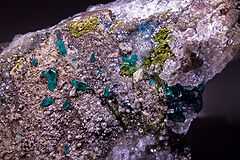Fornacite
From Wikipedia, the free encyclopedia
| Fornacite | |
|---|---|
 Dioptase (blue green), cerussite (light pink) and fornacite (green) from Renéville, Djoué, Brazzaville Region, Republic of Congo | |
| General | |
| Category | Arsenate mineral |
| Formula (repeating unit) | Pb2Cu(CrO4)(AsO4)(OH) |
| Strunz classification | 07.FC.10 |
| Dana classification | 43.4.3.2 |
| Crystal symmetry |
Monoclinic prismatic H-M symbol: (2/m) Space group: P 21/c |
| Unit cell | a = 8.101(2) Å, b = 5.893(11) Å, c = 17.547(9) Å; β = 110.00(4)°; Z=4 |
| Identification | |
| Color | Deep olive-green |
| Crystal habit | Aggregates of steep pyramidal to bladed, rounded crystals |
| Crystal system | Monoclinic |
| Fracture | Irregular/uneven, conchoidal, sub-conchoidal |
| Tenacity | Brittle |
| Mohs scale hardness | 2 - 3 |
| Luster | Resinous, waxy, greasy |
| Streak | Olive green |
| Diaphaneity | Transparent |
| Density | 6.27 g/cm3 |
| Optical properties | Biaxial (+) |
| Refractive index | nα = 2.142 nγ = 2.242 |
| Birefringence | δ = 0.100 |
| 2V angle | Large |
| References | [1][2][3] |
Fornacite is a rare lead, copper chromate arsenate hydroxide mineral with the formula: Pb2Cu(CrO4)(AsO4)(OH). It forms a series with the phosphate mineral vauquelinite.[2] It forms variably green to yellow, translucent to transparent crystals in the monoclinic - prismatic crystal system. It has a Mohs hardness of 2.3 and a specific gravity of 6.27.
It was first described in 1915 and named after Lucien Lewis Forneau (1867–1930) the governor of the French Congo. Its type locality is in Reneville, Congo Republic.[2]
It occurs in the oxidized zone of ore deposits and is associated with dioptase, wulfenite, hemihedrite, phoenicochroite, duftite, mimetite, shattuckite, chrysocolla, hemimorphite, willemite and fluorite.[1]
References
This article is issued from Wikipedia. The text is available under the Creative Commons Attribution/Share Alike; additional terms may apply for the media files.